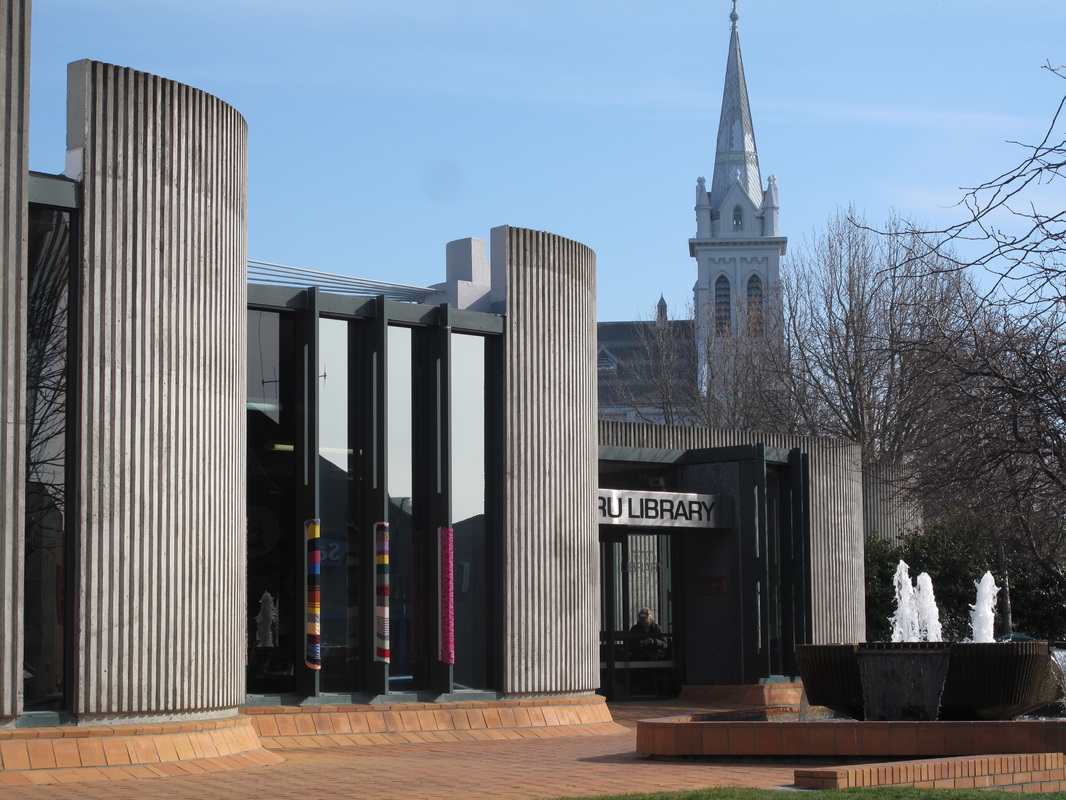|
The Timaru Library was designed in the Christchurch office of Warren & Mahoney and built by C Lund & Son Ltd in 1977.
The project was a major one for the Council, taking over a whole block and carving out a deep pit to house the Civil Defence hub. The sculptured form with its curved concrete walls and shapely rooflights has been much admired. Further, the low profile of the building is respectful of the tall church towers so dominant in this precinct. However the building has some technical failings. The textured concrete walls are uninsulated, and combined with the extensive use of standard single glazing in aluminium frames across the entire south face of the building, energy conservation was not high on the agenda. From the start there were problems with the roof. A new wood-based sheet material was specified as sarking under the Butynol membrane roofing. While this boarding was chemically treated to resist decay it was still capable of absorbing large amounts of moisture and thereby losing strength. The boarding became saturated – not from above but from all of the construction moisture rising from the new concrete work. The situation appeared to be calamitous, but after some expert advice the situation righted itself. The new sarking material rapidly disappeared from the market. The steel roof structure is complicated. The curved trusses that span across the roof are stabilized by the steel rods that tie the trusses to a major concrete column near the entry, showing in this photograph. The Council was advised to regularly test these Macalloy rods to check that their stress levels remain at the correct tension. Can such a burden be loaded on the client when the building is a library full of fixed shelving, and columns could have been designed throughout the interior without any loss of amenity. David McBride
0 Comments
Following on from the previous article on the Royal Arcade, this image shows the exterior of a staircase in the arcade that is not well known. However in its day it was the public thoroughfare to a very popular place - the Arcade Cafe. The Arcade Cafe was on the top floor of the 1906 Priest and Holdgate extension, and designed by the architect J. S. Turnbull.
The cornerstone tenant for the new building was the Cafe, run by Mr Budd, who was expanding from smaller premises next door. The staircase was ascended after walking past the glass display cabinets of the large ground floor confectionary and cake shop, and the stairs opened out to a large dining room that could seat 120 people. Upstairs also contained an alcove for an orchestra, and a ladies’ dressing room and mens’ smoking and coffee room (as well as lavatory ’conveniences’). From the stamped steel ceiling to the linoleum floor with thick under-felt it boasted the most modern features. All new crockery and metalware was inscribed with “Timaru N.Z. Arcade Cafe”. The dining room had two fireplaces so that it could be partitioned into two rooms if required. And although there was a kitchen and scullery upstairs, most of the food preparation was done downstairs in the original premises. The Arcade Cafe was opened almost 110 years ago on the 9th October 1906, with 400 people dining during the day and a large banquet that evening for the Builders’ Association Dinner. However the Arcade Cafe has long gone, and the only people now who ascend the staircase with its outstanding art nouveau stained glass window are those who are going to the Bronz Beat Studio of Dance. Christopher Templeton John Rogers, co-owner of the historic Evan's Atlas Flour Mill which he and Peter Alexander upgraded into workshops, replaces copper and lead stolen from the roof while the building lay empty. The Timaru District Council now has a policy as to how it will allocate money to help protect the district's built heritage. Its just-adopted Built Heritage Protection Fund policy formalises old guidelines that both explain and limit how the fund will be applied. Funding assistance will generally be limited to $5000 per application and preference will be given to applications to tackle several buildings at once. Only buildings identified as a heritage building in the district plan will be eligible for help and only work to preserve the external appearance, or structural work, will be considered. The council's resource planning and regulation committee discussed the policy last week, noting the situation may change with the District Plan review. Councilors also noted a lack of public awareness of the $20,000 annual fund: Councilor Pat Mulvey said "you could count on one hand" previous applications. Heritage-listed building owner Peter Alexander said $5000 would "be very helpful" for repainting a building but was "a drop in the bucket" relative to overall costs. The joint-owner and manager of the Evans Atlas Flour Mill, who previously restored the Oxford Building on Stafford St, expected to pay $70,000 to replace the mill's roof. The building had already been quake-strengthened, but post-Christchurch-earthquake insurance costs were also big expenses, Alexander said. District planning manager Mark Geddes told councilors the Timaru District Heritage Fund Trust could be used with the council's fund to help finance heritage preservation. The Civic Trust might also be interested in jointly-funding such preservation, and the idea should be explored, Geddes suggested in his report to councilors. Civic Trust chairman David McBride was open to the possibility. In the meantime, he hoped recent discussions led by Geddes on revitalising Timaru's CBD might have a positive impact on heritage buildings. Once older buildings were restored, the initial investment of fixing them up was quickly recovered in most cases due to revitalisation and repopulation, he said. Geddes told councilors preserving and maintaining historic buildings was expensive, but necessary to help preserve the district's architectural history. This week, Geddes said increasing the amount of the Built Heritage Protection Fund was "definitely an option" that could be looked at in the future. - Stuff Caroline Bay is one of the most popular spots for locals and visitors to the city. Timaru needs to find and sell its own story, if it wants to attract more tourists. That's the advice of Christchurch Airport chief executive Malcolm Johns, who was also deputy chairman of Tourism New Zealand for six years. "Everyone says you should invest more money, but all you need to do is understand 'what is the story of Timaru?'," Johns said.Christchurch Airport CEO Malcolm Johns with South Canterbury Chamber of Commerce chief executive Wendy Smith. Addressing an audience of about 40 at a lunch hosted by the South Canterbury Chamber of Commerce on Thursday, Johns spoke of the importance of harnessing all that was unique to an area. Citing Christchurch as an example, he said the earthquakes had been unique to the city, as was its service to Scott Base in Antarctica, and those 'stories' had been used to help market the city effectively. Caroline Bay's aviary is another popular attraction. In terms of Timaru, he said as soon as he arrived he had immediately noticed the town still had its heritage buildings. This was an obvious, under-utilised asset, he said."Timaru's still got heritage value. It only needs imagination. "Immediately you can see how [Timaru] could add into the Mackenzie-Christchurch equation," he said. Timaru District Mayor Damon Odey did not agree the town's heritage buildings were under-utilised and said many owners had made efforts to restore building facades. Odey said some visitors came just to see the buildings, as building tours run by David McBride of the Civic Trust demonstrated.However, Odey agreed "100 per cent" with Johns' suggestion of the need for a regional approach to tourism. "We are part of the newly published Canterbury Visitor Strategy which sees us working with Christchurch Airport," Odey said. "We are doing a targeted tourism marketing campaign with Air NZ in relation to the new plane service, capitalising on the Alps to Ocean and people spending time in South Canterbury, via transiting in and out of Timaru's airport, which we're upgrading to meet the new demand," he said. Tourism Industry Aotearoa (TIA) chief executive Chris Roberts said communities across the country could reap greater gains from tourism if local councils grasped opportunities. Only a fraction of tourist spending occurred in tourism-specific places, such as hotels and attractions. The rest took place in cafes, bars, supermarkets, petrol stations, vineyards and other local businesses, Roberts said. Johns saw rival tourist attractors, such as Otago's penguin colonies and the Mackenzie District's astro-tourism, as "powerful allies" for Timaru. But visitors en route to attractions further south, and a predicted increase of tourism overspill from the Mackenzie could be better captured if Timaru promoted a stronger identity, he said. "All you want to do is get people to stop here." Catering directly to potential visitors was another way of getting them to stay locally, he said. In the case of the booming Chinese market, providing menus in Mandarin and Chinese food were good ideas as Chinese tourists did not tend to like "bacon and eggs" and were unlikely to stay if they could not find food they could relate to. Numbers of Chinese tourists were expected to increase further, with the percentage having risen from 6 to 30 per cent in the past five years. Chinese tourists were typically educated and wealthy, spending 24 per cent more than the national average whilst travelling, Johns said. Many were "not going anywhere near tourist spots", he said. A Christchurch airport invitation to a group of executives from China Southern Airlines to view the South Island's greatest attractions in helicopters had led to them signing a deal to bring more international tourists through the airport. "Being parochial, being provincial, rules you out of discussions like that," Johns said. Odey travelled to China's largest mayoral tourism conference this year, and was part of the first Local Government New Zealand mayoral tourism delegation to travel to China last year, through which he was able to market Timaru and South Canterbury directly to the massive Chinese market, he said. -Stuff.co.nz HAYDEN WILLIAMS Last updated 16:15, July 29 2016 Dunedin based architect James Hislop designed some of Timaru's impressive brick mill buildings, addressing the coast like sentinels along the shore. But Hislop also designed commercial buildings including the anchor building at the Stafford Street end of the Royal Arcade.
Located on the southeast corner, the building was erected for the builders' merchants Priest & Holdgate. This is a beautiful piece of work, the Stafford St frontage quite ornately detailed while the long flank forming the arcade is largely unpainted so that the original craftsmanship remains for all to see. The detailing along this façade is superb, the plastered keystones and brick voussoirs forming unique arches over most of the windows at first floor level. An item of much intrigue is the underground railway line linking this building with the original railway station for the transport of goods. Further along, on the same side of the arcade stands the Priest & Holdgate extension. Purpose built as a tea room, subsequently the large open space on the upper floor has been used for many years as a dance studio. The pressed tin ceiling is of particular note. Again the upper façade of this building has never been painted, gaining with age the subtle glow of faded plaster, adding to the continental flavour of the precinct. Across the arcade, the building labelled Arcade Chambers also remains unpainted and shows a style of decoration often employed in Edwardian times – simple bands of brickwork and plaster. These two trades were the essential elements in creating the quite consistent imagery of the original buildings in the central business district of Timaru. David McBride |
View by date Archives
February 2021
Categories |
|
|








